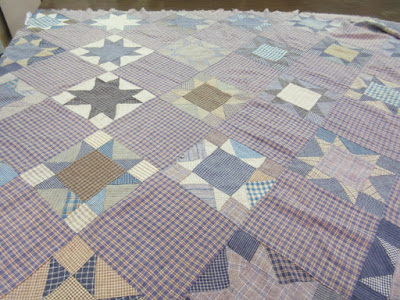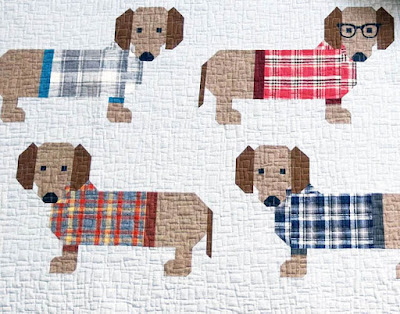Alamance Plaid quilt, by a "member of the Gurley or
Hines family, probably Margaret Gurley Hines (Mrs. Edwin Hines)
(b. ca. 1852), Wayne County, North Carolina, 1880–1910.
Cottons, cotton-wool mixtures." Colonial Williamsburg collection.
"Although fragile and much worn, the charming quilt documents the popular Alamance plaids made in that county of northern North Carolina since the mid-1850s. In 1880, seven mills in Alamance County were producing the popular cotton plaids, and by 1884, the Southern Plaid Manufacturers’ Association represented 2,300 plaid looms. By the early 1890s, the textiles were exported throughout the southern states and as far away as New York, California, and Wisconsin. The quilt itself is utilitarian in its choice of materials and design, making use of scraps and small pieces stitched together in a slightly haphazard pattern that echoes the popular crazy quilts of the day."https://emuseum.history.org/objects/96359/quilt-pieced-from-alamance-plaid-cottons;jsessionid=7E3F3771855C95C1388867F879BA8DC1
Well said! But for those of us who live outside the South and never get to see a quilt like this in the cloth---We have questions. One of the problems is the confusion over terms. Is homespun spun on wheels and woven on looms at home? Can you tell an Alamance plaid from one milled in a different factory North or South? Just what is an Alamance plaid?
Lynn Lancaster Gorges and Suzanne McDowell have been working on questions about Alamance plaids for quite a while. They've examined the plaids in fifty plus quilts in Lynn's collection and quilt blocks and fabric swatches and read extensively about the history of Southern plaids.
From Lynn's collection
Now that is a tough question, which as Lynn said about all of these concepts, is not easily answered in a Facebook bite.
Library of Congress
Doris Ulmann photographed an unnamed woman
spinning in the upland South in the early 1930s.
My guess: She's showing how she spins wool.
Cotton is difficult to hand spin so factory-spun cotton
was often combined with hand spun wools.
Southern fabric industry portrayed by Thomas Nast in 1882
We can be pretty confident that the majority of the yarn-dyed checks & plaid cottons we see in quilts made after 1880 were factory made. It's more an observation on context than being able to distinguish the hand versus the machine in the actual fabric unless you are using a microscope and have Suzanne's eye for weaving.
The seller advertised this quilt as having a homespun backing.
Do all the customers realize it's a look rather than a description of
how it was made?
Ad for "North Carolina Plaid Homespuns" & "Striped Homespuns"
in a Raleigh newspaper in 1861, just before the Civil War began,
describing factory-made cloth.
The rather mythical term goes back generations.
Current woven designs like this "Homespun Gatherings" collection
are often manufactured in India
In her book on the Black family quilts Laurel Horton described a similar backing as "a coarsely woven brown and white houndstooth check, an example of the ginghams produced widely by southern cotton mills...known generically as 'Alamance' plaids or ginghams."
From Lynn's collection
Coarse cottons of yarn dyed pattern.
Blue and brown combinations are often seen in the quilts.
Again we have a term with several meanings, style and technology. "Alamance plaid" is a look but also in a narrower sense any yarn-woven cotton pattern woven at the Alamance mills in Alamance County, North Carolina.
We can focus here on the late-19th-century/early-20th-century versions of Alamance plaids, which Lynn and Suzanne find to have a PIC count of 32 x 32 up to 40 x 40. PIC refers to the weft threads per square inch, the picks. The higher the number the finer the cloth. The quilt fabric we buy today ranges from a minimum of 60 up to 80.
Lynn:
Lower numbers indicate the coarser fabric that seems so distinctive in these Southern style quilts.
Homespun-style fabrics from Southern mills in North Carolina and other states were also called North Carolina Plaids, Pamlico Plaids, etc, writes Lynn.
Alamance and Pamlico are two North Carolina counties and each had important cotton mills, the Alamance Cotton Mills and the Pamlico Cottons Ltd.
A 1922 article on yarn-dyed fabrics listed 20 mills, "manufacturers of well known and long established brands of woven colored fabrics of all descriptions." This movie-star-handsome guy T. Holt Haywood was the New York agent (or factor) for a group of textile mills. He seems to have been a Holt, the family behind Alamance County's mills and a leading force in manufacturing and marketing the Southern fabrics after the Civil War. The Holts started the Southern Plaid Association, a trade group with possibly 40 member mills, recalls Lynn.
It seems quite logical that the Holt family mills, the Alamance Cotton Mills, would become the popular generic name for the product, no matter where it was woven.
Lynn:
The North Carolina project photographed this piece of plaid patchwork
Lynn:
"Suzanne and I found that the ["homespun" style plaids] indicates the use of single ply cotton and the fabric has a PIC count of 40 x 40 or lower, therefore making it a looser weave when inspected with a microscope. Often the weave looks tighter because of the sizing applied by the mills onto the fabric. Many manufacturing companies made cloth they called homespun. This was proven using newspaper ads and articles. We have found plaids that are truly home produced that are much finer PIC counts. Primarily we have found that manufactured homespun has more regular threads when viewed under magnification."
Lower numbers indicate the coarser fabric that seems so distinctive in these Southern style quilts.
Garment made from a coarse yarn-dyed cotton.
North Carolina Historic Sites
Homespun-style fabrics from Southern mills in North Carolina and other states were also called North Carolina Plaids, Pamlico Plaids, etc, writes Lynn.
Orange dots are counties we are talking about
Alamance and Pamlico are two North Carolina counties and each had important cotton mills, the Alamance Cotton Mills and the Pamlico Cottons Ltd.
A 1922 article on yarn-dyed fabrics listed 20 mills, "manufacturers of well known and long established brands of woven colored fabrics of all descriptions." This movie-star-handsome guy T. Holt Haywood was the New York agent (or factor) for a group of textile mills. He seems to have been a Holt, the family behind Alamance County's mills and a leading force in manufacturing and marketing the Southern fabrics after the Civil War. The Holts started the Southern Plaid Association, a trade group with possibly 40 member mills, recalls Lynn.
It seems quite logical that the Holt family mills, the Alamance Cotton Mills, would become the popular generic name for the product, no matter where it was woven.
Lynn:
"By the late 1880’s into the 1890’s the plaids were selling for 3-5 cents per yard. Along with the plaids they were making striped jeans and checks/ginghams in homespun weight....
Bonnie found this string quilt with 2 yarn-woven patterns
on the back in North Wilkesboro, North Carolina, up by the
Virginia line in Wilkes County. Virginia had plaid mills too,
notably the Dan River mill. See her post here:
Lynn:
"Many NC quilts continued to have plaid backs way into the 20th century because the yardage was so cheap women would buy it up and stash it. The most popular colors are blue and brown but there are also plaids with green and coral."
Quilt found in the West Virginia project but attributed to
Caroline Forbes of Pitt County, North Carolina.
Lynn continues:
"I am going to confuse y’all more. Suzanne and I have also found some plaids like the ones we call southern plaids in New England. So were they made there or sold up there? We do know that much of the equipment used for the start of the southern mills came from New England. We also know that these southern plaids were sold in South America, New Orleans, Louisville, Philadelphia and many other places. We have ads in old newspapers to back that up."
Collection of the North Carolina Museum of History,
Associated with Edith Uzzell (1837-ca. 1914), Wayne County, North Carolina
Curator Diana Bell-Kite posted this picture. I like the term "Associated with."
"I grew up in Wayne County. So far the most plaid quilts have been documented in Wayne County. That is maybe because it was the HUB of the railroad in the east coast. Due to that bales of plaids came into Goldsboro often. A bale had 1,000 yards in it. Check out newspapers.com for ads in Goldsboro around 1890. Weils General Store often sold them.
H. Weil & Bros., Wholesale & Retail
North Carolina Office of Archives and History
Lynn's collection
So all we can come up with here is that both terms homespun and Alamance plaid are determined by the context.
An Alamance plaid is a style---a common style of Southern plaids, some of which were produced in factories in Alamance County, North Carolina. Some of which were not.
Calling this style of quilt pieced of yarn-dyed coarse cottons
an Alamance Plaid Quilt refers more to its style than the source
of the fabrics, but the term does communicate. The style was popular maybe
1890-1930, particularly in the South and particularly in North Carolina.
Quilt dated 1928 from an ebay seller in Davidson County, North Carolina
And "homespun", like "hot dog", tells you nothing about how the product was made.
Dogs in Sweaters quilt pattern by Elizabeth Hartman
Adopted North Carolinian Erma Kirkpatrick first called our attention to these plaids in quilts in an ASQG paper. http://www.quiltindex.org/journals/article.php?Akid=2-B-9A
See more:
https://barbarabrackman.blogspot.com/2018/09/the-problem-with-plaids-1.html
https://barbarabrackman.blogspot.com/2018/09/the-problem-with-plaids-2.html
https://barbarabrackman.blogspot.com/2018/09/the-problem-with-plaids-1.html
https://barbarabrackman.blogspot.com/2018/09/the-problem-with-plaids-2.html
























No comments:
Post a Comment